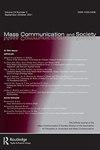The Effects of Responsibility Frames and Stigmatizing Headlines in News on Support for COVID-19 Policies in Korea: The Mediating Roles of Responsibility Attribution and Emotions
IF 2.7
2区 文学
Q1 COMMUNICATION
引用次数: 0
Abstract
This study examined the mechanisms through which responsibility frames and stigmatizing headlines influence support for governmental policies to address the pandemic. Based on a factorial design experiment, we examined the effects of 2 responsibility frames (individual vs. societal responsibility) and 4 headline types (non-stigmatized vs. name-stigmatized vs. characteristic-stigmatized vs. both-stigmatized). The results showed that the individual responsibility frame increased individual attribution of responsibility for the cause and spread of COVID-19 whereas reducing societal attribution of responsibility, compared to the societal responsibility frame. The headline that detailed both the stigmatized characteristic and name increased individual attribution of responsibility compared to the non-stigmatized headline. Furthermore, the effects of frames and headline types on policy support were sequentially mediated by attribution of responsibility and emotions. Individual attribution of responsibility led to anger whereas societal attribution of responsibility led to sympathy. Subsequently, anger increased support for punitive polices while sympathy increased support for assistive policies. This study contributes to the literature on news framing of pandemics by integrating cognitive and emotional mechanisms in forming policy attitudes. [ FROM AUTHOR] Copyright of Mass Communication & Society is the property of Taylor & Francis Ltd and its content may not be copied or emailed to multiple sites or posted to a listserv without the copyright holder's express written permission. However, users may print, download, or email articles for individual use. This may be abridged. No warranty is given about the accuracy of the copy. Users should refer to the original published version of the material for the full . (Copyright applies to all s.)责任框架和污名化标题对韩国COVID-19政策支持的影响:责任归因和情绪的中介作用
本研究考察了责任框架和污名化标题影响对政府应对大流行病政策支持的机制。基于析因设计实验,我们检验了2种责任框架(个人责任vs社会责任)和4种标题类型(非污名化vs名污名化vs特征污名化vs双污名化)的影响。结果表明,与社会责任框架相比,个人责任框架增加了对新冠肺炎病因和传播的个人责任归因,而降低了社会责任归因。与非污名标题相比,同时详述污名特征和姓名的标题增加了个人的责任归因。此外,框架和标题类型对政策支持的影响依次被责任归因和情绪中介。个人责任归因导致愤怒,而社会责任归因导致同情。随后,愤怒增加了对惩罚性政策的支持,而同情增加了对辅助政策的支持。这项研究通过整合形成政策态度的认知和情感机制,为关于流行病新闻框架的文献做出了贡献。【来自作者】《大众传播与社会》的版权是Taylor & Francis Ltd的财产,未经版权所有者的明确书面许可,其内容不得复制或通过电子邮件发送到多个网站或发布到listserv。但是,用户可以打印、下载或通过电子邮件发送文章供个人使用。这可以删节。对副本的准确性不作任何保证。用户应参阅原始出版版本的材料的完整。(版权适用于所有人。)
本文章由计算机程序翻译,如有差异,请以英文原文为准。
求助全文
约1分钟内获得全文
求助全文
来源期刊

Mass Communication and Society
COMMUNICATION-
CiteScore
6.90
自引率
3.30%
发文量
58
期刊介绍:
Mass Communication and Society" mission is to publish articles from a wide variety of perspectives and approaches that advance mass communication theory, especially at the societal or macrosocial level. It draws heavily from many other disciplines, including sociology, psychology, anthropology, philosophy, law, and history. Methodologically, journal articles employ qualitative and quantitative methods, survey research, ethnography, laboratory experiments, historical methods, and legal analysis.
 求助内容:
求助内容: 应助结果提醒方式:
应助结果提醒方式:


